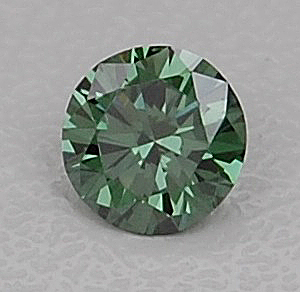.jpg)

Introduction: Diamond is a mineral species. Pictured above is a natural octahedron and a 0.93 ct green irradiated round.
Colors: transparent to opaque; usually very light yellow, brown, gray to colorless. Colorless stones are graded on an alphabetical scale with “D” being the most colorless with increasing amounts of color through “Z”. Diamond more rarely occurs in darker yellows and browns and light to dark tones of blue, green, orange, pink, red and purple. Black stones are also possible.
Clarity: Under 10x magnification, diamonds are graded as:
F - flawless
IF - internally flawless
VVS1, VVS2 - very very slightly included
VS1, VS2 - very slightly included
SI1, SI2 - slightly included
I1, I2, I3 - imperfect
Stone Sizes: Finished stones in the hundreds of carats have been cut. Among the largest are the Cullinan I at 530.2 carats in the British Crown Jewels. Typical jewelry sizes are up to 5 carats although larger stones have certainly been used on occasion.
Localities:
-Botswana, South Africa, Russia, Australia, Canada, Namibia, Brazil, India
Treatments:
-Irradiation (R) often followed by controlled heating can produce green, brown, blue, yellow, orange, pink, purple or red. The resulting color is stable but may change if exposed to high heat as may be used during a jewelry repair. This process is commonly done and is detectable.
-HPHT process is a relative newcomer to the treatment arena. Diamonds of a certain type can be exposed to hight temperature, high pressure to improve the color grade. This process can also yield the same fancy colors as irradiation. The resulting color is stable and permanent even if exposed to the high heat of a jewelry repair. The treatment is detectable.
-Laser drilling and bleaching is common. It has the effect to lighten dark inclusions, making them less obvious. The process is stable and can be detected with magnification.
-Filling cracks on stones of low clarity to make cracks less apparent as well as coating to improve color or mask unattractive colors are both occasionally done and can be detected with magnification.
Gemology:
-Refractive Index: 2.417
-Birefringence: None
-Optic Character: Singly refractive
Dispersion: 0.044
Specific Gravity: 3.52 (+/- 0.01)
-Hardness: 10
-Toughness: good in cleavage directions; excellent in other directions
-Chemical Composition: C
-Cause of Color:
yellow, orange: nitrogen and related color centers
blue: boron
green: color center due to irradiation (natural or treated)
red, pink, brown: unknown
-Fluorescence: Colorless to yellowish stones are inert to strong, usually blue in LW, weaker in SW.
-Absorption Spectra: Irradiated and annealed diamonds when cooled to low temperatures can show a thin line around 594 nm. Unfortunately, natural diamonds from China can show the same line. Irradiated stones do show a band around 743 nm, seen with advanced gemological equipment.
-Cleavage: perfect in four directions
-Phenomena: None
Name: Diamond is from the Greek word, adamas, meaning the hardest steel.
Dates: Diamond is the birthstone for April and the gem for the 10th and 60th anniversaries.
Care: The ultrasonic and steam cleaner are generally safe. Warm, soapy water is safe.
To see available diamonds, click here.
